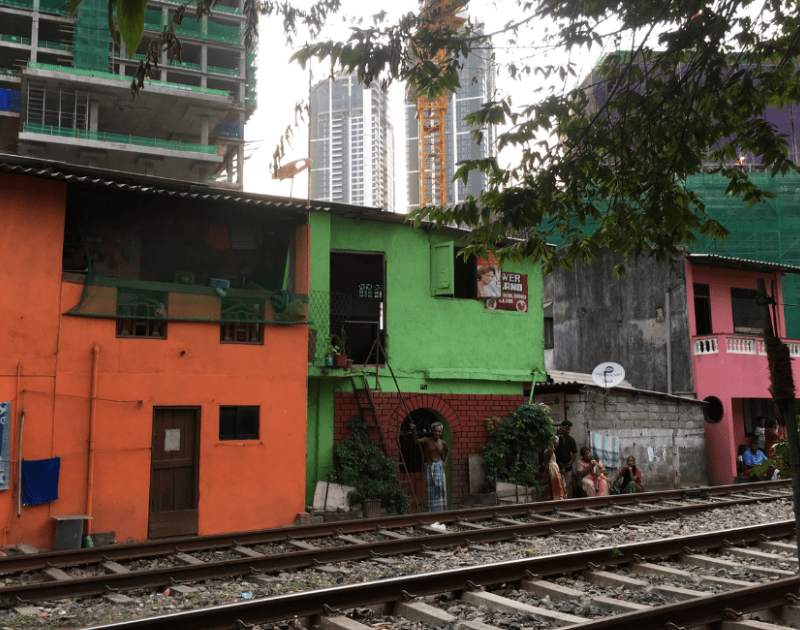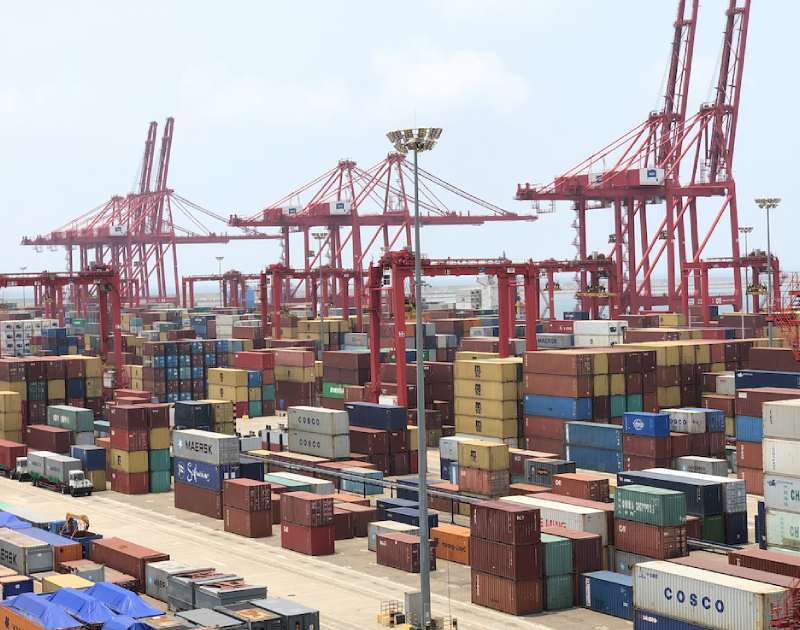
- Home
- Knowledge Insights
- Dirty Business: Reading modernity in Colombo’s fish markets
“Like all promises made by politicians, the promise of a hygienic new fish market with modern amenities remains merely a promise. The new market complex is in fact much worse than the old fish market.”
The above quote is taken from a newspaper article titled “Filth and Fish at Peliyagoda Fish Market”, written in 2019, about seven years after the market opened. Captions of photos highlight the incongruence between the promised modern market and how it is now used. We are told that ‘‘Hygiene is not on this vendor’s mind as he displays his wares beside a drain” and “crows flock to the market with its “modern amenities””. By drawing our attention to the fact that the promised new market is in fact worse than its predecessor, we begin to question the feasibility of the promise in the first place. Is it possible to have fish without filth?
In Sri Lanka, fish markets have been described as places of filth and disorder for decades. The Asian Development Bank noted in 2007 that “prevailing health and hygiene levels in St Johns [sic] Fish Market (Colombo’s existing market) are well below the minimum required standard.” In the 1980s, UDA planners assure us that at St. John’s “operations were conducted in absolute squalor” and “the condition of the temporary market is deplorable to say the least” (UDA, n.d). Under colonial rule we fared no better, as Dr. William Phillip, Medical Officer of Health at the Colombo Municipal Council in 1906, writes that public markets are “a positive disgrace to the town” and that fish and meat are “being exposed under the most unsanitary conditions”.
Why are fish markets consistently decried as filthy, and what does that say about urban space and our changing ideas of what is acceptable in our cities? While adding fish markets to the list of national failings may be the simplest course of action, a closer examination of how these markets are perceived by urban planners and administrators, offers us insight into dominant ideologies of planning, municipal governance and public health that continue to influence our cities today.
For colonial administrators, the idea that diseases originated from miasmas and bad odours was particularly tenacious and continued to influence urban planning and public health in the tropics even after germ theory was widely accepted(Ramanna, 2002). Fish markets no doubt represented a source of contagion and disease, because of their smell, but also because of the disorder and chaos they fostered. In Colombo’s municipal bylaws we see that markets are pathologised, with rules about unlicensed fish and meat stalls sitting alongside prohibitions against unlicensed market servants and disorderly conduct. Even the architectural form of a civic market-hall as introduced to the colonial city by the British can be read as a way of controlling the unruly indigenous bazaar (Sohoni, 2022). Food inspectors not only expunged the marketplace of putrefied fish and other contaminants, but guarded against unscrupulous vendors and vengeful customers, keeping the market an ordered, disciplined oasis.
Fast forward a hundred years and reports of poor hygiene standards at St. John’s in 2008 represent a barrier to wooing discerning export markets, rather than a potential cause of food poisoning in a Colombo suburb. In a similar vein, crowded disordered markets are still problematic but mostly due to the traffic they cause around Pettah.
When markets are filthy and unhygienic, demolition and construction, sometimes with relocation, are put forward as the solution – even in 1906, the Medical Officer advocated for a new central market at a convenient location. Markets in particular present low-hanging fruit for governments looking to give their cities a facelift. Amongst the many preparations for the non-aligned summit in 1976, Sirimavo Bandaranaike’s government demolished the Kollupitiya market, replacing it with a modernist structure designed by Justin Samarasekera. Another victim of the summit prep was the original St. John’s Fish Market in Pettah, which had been built in 1894. In 1978, the Urban Development Authority was established under a newly elected UNP government. One of the first buildings constructed by the UDA was the new St. John’s Fish Market and a concept note for the redevelopment of Pettah developed by the UDA notes:
“Designed by the Chief Architect of the Buildings Department, according to the UDA development plan it will be a three-storey building with ramps sans staircase for the convenience of shoppers. In addition to the fish stalls the market will also provide chicken stalls, dry goods, households utensils, grocery shops, offices and snack bars and to top if off — a roof top restaurant.” (UDA, n.d)
The building was completed in 1983. In 2012, the latest iteration of the cycle of dirt, destruction and rebuilding was completed as the St. John’s market was demolished and the fish market moved 5km away to Peliyagoda, outside the limits and mandate of the city of Colombo.
Absent from these conversations is maintenance, and the largely hidden labour that ensures markets, infrastructure and society runs without glitch. One reason could be that these views are usually expressed by planners and administrators rather than vendors and customers, the people who use the space the most. Throughout the cycles of destruction and construction, the opinions of those whose livelihoods are most affected by these decisions have never been consulted. While many vendors did not want to move from Pettah to Peliyagoda, they still had opinions about the state of the market. href=”https://www.sundaytimes.lk/060212/ft/16.html” target=”_blank”>One vendor stated “I have been selling fish for the last 20 years. Earlier there were good facilities, toilets in working condition, water etc. Today most of the toilets are broken and those which are in use are stinking. The entire market has become a hell-hole, with huge holes on the roads and inside the premises with these holes filled with dirty water and fish-blood, people are forced to walk through”.
During our research earlier this year on Colombo’s grid infrastructure and food environment, vendors echoed these sentiments about the Peliyagoda Central Fish Market, complaining about the state of the toilets, as well as the lack of maintenance done on the buildings, pointing at the literal cracks in the facade. Even as early as two years into its opening, auditors flagged maintenance problems at the market.
While maintaining an existing building may solve problems of ‘dirt’, building a new market from scratch garners more political will as it offers an opportunity to reshape urban space and add another piece to the jigsaw puzzle of a world class city. Showcasing the present as terrible and beyond redemption lays the groundwork for shiny new buildings that bring the city into its inevitable future. This future is achieved by building among other things, markets that are ‘modern.’
Modern here can be read as both an aesthetic to aspire to, as well adopting the latest technological advancements in infrastructure and facilities, both readings of which are borrowed from Western countries. Each iteration of a new fish market is accompanied by the latest technology and amenities, serving as a reminder that what is modern is a forever shifting horizon that the global south will always fail to catch up to. In the 1950s we see post-independence Ceylon still dependent on foreign experts from Denmark and Great Britain who are dispatched to study the island’s fisheries and produce recommendations (Petersen, 1949; John, 1949). A closer study of these reports shows a bewilderment with local practices, as much as it does an absolute belief in the superiority of Western systems of fishing. Amongst suggestions of canned turtles and germicidal ice, these reports marshall case studies from France and Germany, and suggest fishing regulations be based entirely on Norway’s model (Petersen, 1949). There was little room for the indigenous climate, let alone indigenous knowledge.
Such deference to experts and the latest technology continues today, even when varying contexts lead to failure. Examples of this can be seen in the Peliyagoda Fish Market, where a 50MT flake ice factory was planned, with estimates of LKR 28 million in revenue (ADB, 2007). Eventually a 25 MT capacity flake ice factory was established, according to accepted industrial best practice. The ice factory fell into disuse because flake ice was not the kind of ice that wholesale and retail vendors required. Vendors said that flake ice was too thin and melted too fast, preferring to use block ice which is crushed. A similar reliance on block ice is seen in fishing industries in Kerala and Indonesia (Geethalakshmi et al., 2021; Wibawa et al., 2022) . As of today supplies of block ice have to be contracted out to meet the demand and are bought from lorries parked in the market. With only one supplier of block ice, vendors were vulnerable to price gouging during the crisis where a block of ice went up to LKR 1600 ( the price as of March 2023 was LKR 600). This is even more unfortunate in light of the fact that the Peliyagoda Fish Market received no power outages during the crisis, and had sufficient supplies of diesel for generators to power cold storage rooms. The disjoint between foreign best practice and local implementation may have been bridged if vendors were included in the consultation process of designing and imagining new markets.
What is lost when Western practice is best practice, and Western form is modernity? Vivian Chan (2022) writes that in Hong Kong’s wet markets “wetness permeated the market, both as a source of life, lustre and cleanliness, and as a constant threat to the government’s vision of a clean, modern, working society and urban landscape.” She writes that these markets facilitate the desires and requirements of their customers, particularly considering Chinese cooking practices where strategies such as checking the clarity, shine and fullness of fish eyes are essential for determining freshness and quality. These sensory and tactile approaches are often portrayed as messy and illogical, but they are how shoppers make sense of produce and of the world.
Compared to these wet markets, or even other traditional markets, the supermarket has been promoted as a modern, hygienic and ordered environment that is the best place to buy produce. Apart from being predictable and ordered, they are scrupulously clean and sterile places. Moyer (2009) argues that “cleanness is framed, by food producers and retailers, as a matter of removing and/or revealing traces of a food item’s production history”. As we become more accustomed to our food stripped of traces of production, context and labour, spaces that show the evidence of production in the form of blood, waste, and dirty water become dirty, if not filthy. Despite the fact that fish at Peliyagoda market may be fresher than a fish filet wrapped in plastic at Keells, the supermarket processes the fish out of sight, and thus out of mind for the consumer.
This is not to suggest that sanitation efforts are always cosmetic, and that any attempt to keep a workspace clean is a Western imposition. Rather, it is precisely the act of cleaning, washing, repairing and maintaining that enables markets to function. Urban planners can adopt an approach that seeks to work with what is already there, be it buildings, climate, practices or people, rather than chase an ephemeral modernity.
References
Asian Development Bank, 2007. Major Change of Scope – Sri Lanka Aquatic Resource Development and Quality Improvement Project. Available at:
https://www.adb.org/sites/default/files/project-documents//34318-sri-mcs.pdf
Chan, V., 2022. Markets made modular: Constructing the modern ‘wet’ market in Hong Kong’s public housing estates, 1969–1975. Urban History, pp.1-19.
Geethalakshmi, V., Radhakrishnan Nair, V. and Gopal, N., 2021. Ice Utilization in the Fisheries Sector of Kerala. Available at:
https://krishi.icar.gov.in/jspui/bitstream/123456789/65752/1/Ice%20Utilization%20in%20the%20Fisheries%20Sector%20of%20Kerala.pdf
John, C.C., 1949. Some Suggestions for Developing the Fisheries of Ceylon, in Sessional Paper VI – 1951 Ceylon Fisheries: Recommendations of Experts on Fisheries Development, Research, Socio-Economic and Industrial Problems. pp.110 -151.
Moyer, A., 2009. “All Kinds of Dirty”: Supermarkets, Markets, and Shifting Cultures of Clean. Cuizine, 2(1).Available at:
https://www.erudit.org/en/journals/cuizine/1900-v1-n1-cuizine3403/039513ar/
Petersen, E., 1949. Report on the Handling, Treatment, Packing, Transport, Refrigeration, Storage and Sale of Fish, in Sessional Paper VI- 1951 Ceylon Fisheries: Recommendations of Experts on Fisheries Development, Research, Socio-Economic and Industrial Problems. pp. 40 – 46.
Phillip, W. M., 1906. Appendix B – Report of the Medical Officer of Health, Administrative Report of the Colombo Municipal Council. pp. I-XIX.
Ramanna, M., 2002. Western medicine and public health in colonial Bombay, 1845-1895 (Vol. 4). Orient Blackswan.
Sohoni, P., 2022. Taming the Oriental Bazaar: Architecture of the Market-Halls of Colonial India. Taylor & Francis.
Urban Development Authority, (n.d) Pettah Redevelopment Concept Note.
Wibawa, P.A., Birmingham, R.W. and Warmadewanthi, I.D.A.A., 2022, October. Comparing Life Cycle Assessment of Fish Preservation Method on Fishing Vessels in Indonesia. In IOP Conference Series: Earth and Environmental Science(Vol. 1095, No. 1, p. 012017). IOP Publishing.


